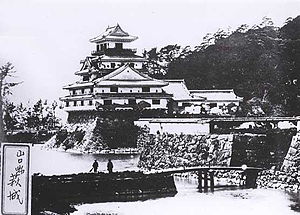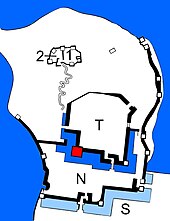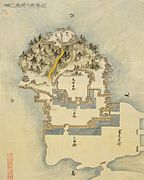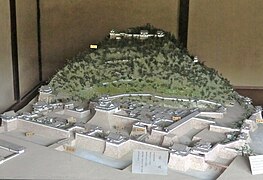Hagi Castle
| Hagi Castle | ||
|---|---|---|
|
Hagi Castle, castle tower before 1900 |
||
| Creation time : | 1604 | |
| Castle type : | Hirajiro (Lower Castle) | |
| Conservation status: | Partly reconstructed | |
| Place: | Hagi | |
| Geographical location | 34 ° 25 '17.1 " N , 131 ° 22' 53" E | |
|
|
||
The castle Hagi ( Japanese 萩城 , Hagi-jō ) is located in the city of Hagi , Yamaguchi Prefecture . In the Edo period , the Mōri resided there with an income of 369,000 Koku as the great Tozama daimyo .
history
After Daimyō Mōri Terumoto ( 毛利 輝 元 ) belonged to the losers after the Battle of Sekigahara in 1600, he lost most of his possessions with an income of 1,200,000 Koku. Only the provinces of Suō and Nagato , combined with an income of almost 370,000 Koku, remained with him. Terumoto chose a site at the foot of Mount Shizukiyama ( 指 月 山 ), which forms a peninsula that juts out into the Sea of Japan, as a new residence . After Terumoto had received permission from Tokugawa Ieyasu to build a castle there in 1603 , he began in 1604. The castle was completed four years later, in 1608.
The attachment
The castle at the southern foot of the Shizukiyama received a five-story castle tower ( 天 守 閣 , tenshukaku ), the top floor with emphasis on the lookout function ( s 型 , bōrō-gata ) was created. To the south, the central area, the Hommaru ( 本 丸 ) , was protected three times by the inner ( 内 堀 , uchibori ), middle ( 中 堀 , nakabori ) and outer trenches ( 外 堀 , sotobori ). On the other three sides protect the sea. At the time of the flood, the trenches were filled with water up to the foot of the walls, so that one can almost speak of a moated castle. To the north protected the 143 m high Shizukiyama, on the top of which Terumoto had his own small castle built in case of emergency, the Tsumu-no-maru ( 詰 の 丸 ). Like the lower castle, this was divided into a Hommaru and a Ni-no-maru ( 二 の 丸 ) and had five two-story watchtowers.
The Hommaru at the foot of the mountain is also called the “castle tower area” ( 天 守 曲 輪 , tenshu-kuruwa ), the local Ni-no-maru corresponding to Ni-no-kuruwa ( 二 曲 輪 ). The wall around the Ni-no-kuruwa was over a kilometer long and had 12 watchtowers. Further upstream is the San-no-kuruwa ( 三 曲 輪 ), which was also called "Inside the honorable castle" ( 御 城内 , go-jōnai ).
After the Meiji Restoration, the castle buildings were demolished. Only the walls and the inner moat have been preserved. The castle grounds became a park under the name "Hagi Castle Ruins Shizuki Park" ( 萩 城 跡 指 月 公園 , Hagijō-ato Shizuki Kōen ). The former main house of the Fukuhara, the Fukuhara-ke Shoin ( 旧 福 原 家 書院 ), is located next to the Shizukiyama shrine ( 志 都 岐山 神社 ). The Fukuhara were the heads of the administration of the Han and had an income from a small daimyo, namely 11,000 koku.
photos
literature
- Kato, Masafumi: Hagi-jo in: Miura, Masayuki (ed.): Shiro to jinya. Saikoku-hen. Gakken, 2006. ISBN 978-4-05-604379-2 .
- Nishigaya, Yasuhiro (Ed.): Hagi-jo. In: Nihon meijo zukan, Rikogaku-sha, 1993. ISBN 4-8445-3017-8 .







